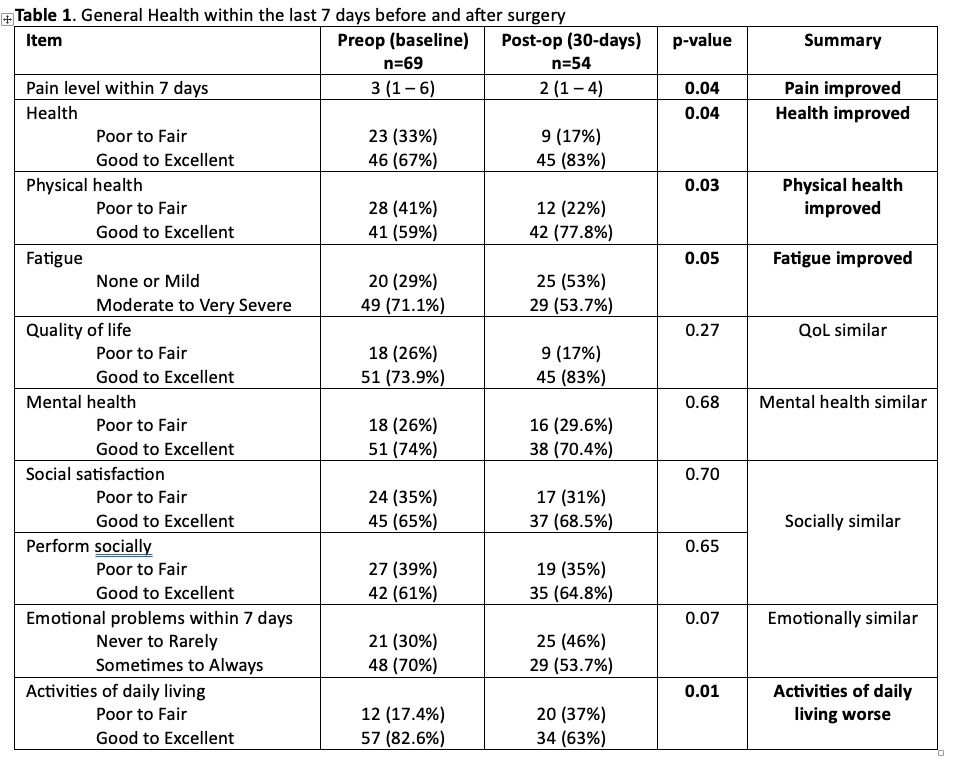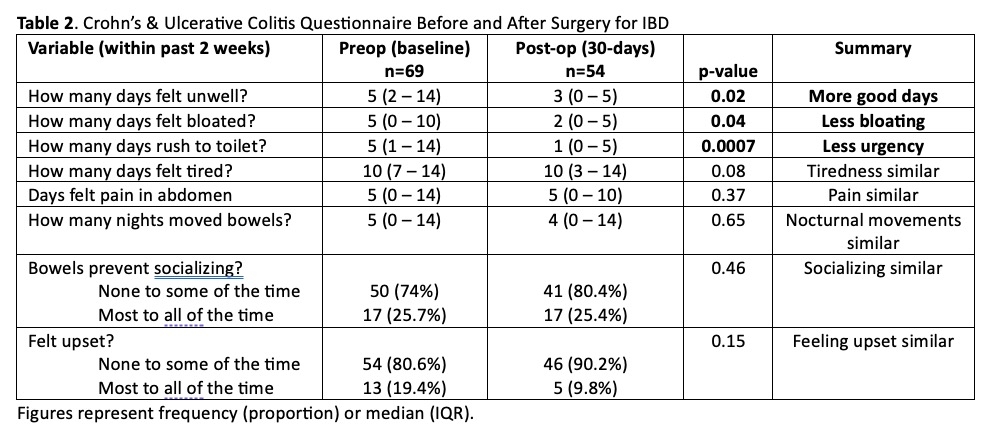Back to 2024 Abstracts
DOES SURGERY FOR IBD DELIVER ON IT'S PROMISES? IMPACT OF SURGERY ON SHORT-TERM PATIENT REPORTED OUTCOMES FROM THE CROHN'S & COLITIS FOUNDATION'S SURGICAL INNOVATIONS, RESEARCH, & QUALITY COLLABORATIVE
Stefan D. Holubar
*1, Samuel Eisenstein
2, Karen Zaghiyan
5, Kinga S. Olortegui
4, Muneera Kapadia
7, Sarah Stringfield
6, Alessandro Fichera
6, Phillip Fleshner
5, Neil Hyman
4, Roger D. Hurst
4, Jeremy M. Lipman
1, Nicole Lopez
2, Lisa A. Parry
2, Benjamin D. Shogan
4, Jonathan Stem
7, Sonia Ramamoorthy
2, Katerina O. Wells
6, Caroline Perry
3, Megan Villarreal
3, Alandra Weaver
3, Caren Heller
31Colon and Rectal Surgery, Cleveland Clinic, Cleveland, OH; 2University of California San Diego, La Jolla, CA; 3Crohn's & Colitis Foundation, New York, NY; 4University of Chicago Pritzker School of Medicine, Chicago, IL; 5Cedars-Sinai Medical Center, Los Angeles, CA; 6Baylor Scott & White Health, Dallas, TX; 7The University of North Carolina at Chapel Hill, Chapel Hill, NC
As part of the Crohn's & Colitis Foundation's IBD Plexus, a novel prospective, longitudinal multicenter surgical inception cohort was implemented. In this first report from the first 100 patients enrolled, we aimed to assess patient reported outcomes before and after IBD surgery. We hypothesized surgery is associated with improved patient reported outcomes.
MethodsBeginning in Aug. 2022 patients were prospectively enrolled into a multicenter IRB-approved observational longitudinal cohort at 6 centers with 17 enrolling surgeons. Inclusion criteria: adults undergoing major abdominopelvic surgery for a known diagnosis of IBD. Baseline demographics, intra-operative details, 30-day outcomes, and patient reported outcomes were recorded at baseline and 30-days postoperatively. Overall health status was assess using the PROMIS General Health measures, symptom specific measures: PROMIS Pain Interference, Fatigue, and Sleep scales, and disease-specific measures: the Crohn's & Ulcerative Colitis Questionnaire items. Figures represent frequency (proportion), median (range). P-values represent Wilcoxon rank-sum test or chi-squared test or Fisher's exact test.
ResultsA total of 103 patients were enrolled to date; median age 43 (20 – 74), 49% female, diagnoses: Crohns (64%), ulcerative colitis (35%), and IBDu (1%). A total of 69 (67%) patients completed surveys, and 58 (56%) patients completed the post-operative survey. In terms of overall health status within 7 days, improved overall median pain scores (3 vs. 2, p=0.04), overall health (p=0.04), physical health (p=0.03), and less fatigue (p=0.05) were observed after surgery compared to baseline (
Table 1), while overall quality of life, mental health, social measures, and emotional problems were similar. Patients reported more difficulties with activities of daily living after surgery (p=0.01). In terms of symptoms within 7 days, less fatigue (p<0.05), but no difference in pain interference or sleep disturbance was observed after surgery (p>0.05). In terms of disease-specific outcomes within 2 weeks, fewer days feeling unwell (5 vs. 3, p=0.02), bloated (5 vs 2, p=0.04), or needing to rush to the toilet (5 vs 1, p=0.007), and no difference in feeling tired, upset, abdominal pain, or nocturnal bowel movements was observed after surgery.
ConclusionsIn a prospective longitudinal cohort, surgery was associated with improved pain and physical health scores, with fewer days feeling unwell, fatigued, bloating, and fecal urgency. On the other hand, mental, social, and emotional health did not change 30-days after surgery. Our data suggest patients are still recovering 30-days after surgery, and longer follow-up may reveal further improvements. Targeted psychosocial interventions and support at home early in the acute post-operative period may improve the quality of recovery after surgery for patients with IBD.


Back to 2024 Abstracts

